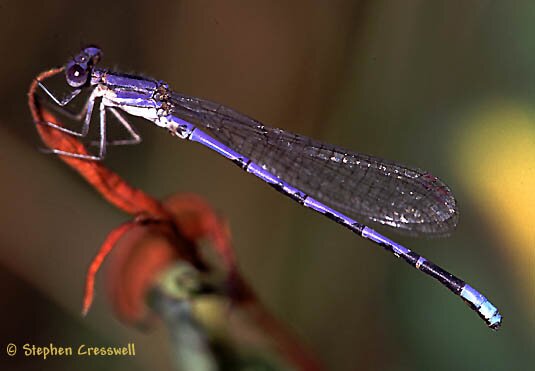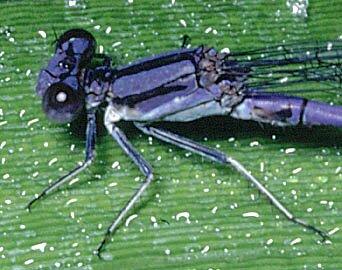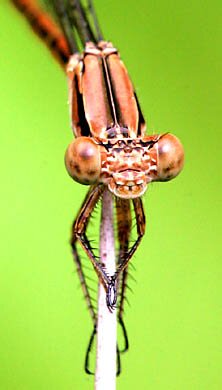

Family: Coenagrionidae
Length: 30-34 mm
As the common name says, this species is variable in appearance. So much so that scientists have described three subspecies based on differences in markings and in wing color. West Virginia is home to subspecies Argia fumipennis violacea, and it is this subspecies that is described and pictured here.
 No other West Virginia damselfly has this purple coloration in the male. The male's abdominal tip (segments 9 and 10) are pale blue.
No other West Virginia damselfly has this purple coloration in the male. The male's abdominal tip (segments 9 and 10) are pale blue.
Both male and female have their dark shoulder stripe forked.
This beautiful damselfly is most often encountered from May to September in the Mountain State. Either ponds or streams form acceptable habitat for the Variable Dancer, but it prefers well-vegetated locations. When not actively seeking a mate these damselflies may also be found well away from the nearest body of water. It perches not only on plants but on rocks, logs, and the ground.
A brown-winged form of the Variable Dancer is common farther to the South, and in fact the first Argia fumipennis description was of the dark-winged form, published by Burmeister in 1839. Twenty-two years later Hagen described the clear-winged form as a new species, Argia violacea.
In 1968 Leonora Gloyd published an NSF-funded study, based on her examination of 2,000 specimens of Argia fumipennis and A. violacea. Gloyd's study revealed "nothing in either males or females by which fumipennis and violacea can be separated." Thus, since 1968 violacea has been regarded as a subspecies of Argia fumipennis. Gloyd also named another subspecies, Argia fumipennis atra, which has very dark brown wings and is found in Florida.

|
| Two views of the male Variable Dancer. Note the forked black shoulder stripe. The legs are pale with dark markings. |

|
 |
 |
| The face, eyes, and much of the dorsal surface of the male's thorax are purple. | The typical female coloration includes tan, brown, and black. |


